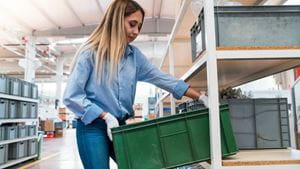TILE in Manual Handling
No matter the job or industry, manual handling is a task that almost everyone will carry out at some point in their working life. However big or small the task, the consequences of unsafe manual handling can be very severe and it is vitally important that health and safety guidance is followed at all times.
Along with manual handling weight limit guidance and appropriate lifting techniques, a key part of safe manual handling is reducing or removing risk as much as possible before a task is carried out. Using TILE is one way to ensure that every task is as safe as possible, acting as a reminder for all the factors that should be considered before manual handling takes place.
What is manual handling?
Manual handling refers to any physical activity that involves moving or supporting a load with your body or hands. This can involve lifting, pushing, lowering, carrying, pulling or transporting a load.
A ‘load’ in manual handling does not just apply to an inanimate object; it can also refer to the handling of a person or an animal. Those who work in hospitals or care homes may have to move patients and residents from time to time, or jobs in the veterinary and farming industry may require the handling of animals.
The laws on manual handling state that employers have a duty to protect their staff from the risks associated with handling loads, which should be done by:
- Avoiding hazardous manual handling as much as possible
- Completing a manual handling risk assessment if hazardous manual handling has to take place
- Reducing the risk of injury from manual handling as much as possible before a task is carried out
Although the law does not give specific weight limits for manual handling, there is guidance in place for manual handling weight limits to protect individuals from lifting or moving loads that are too heavy for them.
Legal manual handling guidelines suggest that the maximum safe lifting weight for women is 16kg, and the maximum safe lifting weight for men is 25kg. These limits change depending on the size of the object and where and how it is being moved however, and it is the responsibility of an employer to check that their staff know these limits and do not exceed them
Along with manual handling lifting limits, to minimise the risk of injury from manual handling there are health and safety guidelines for lifting at work that outline the proper techniques for handling, carrying, lowering or lifting heavy loads.
What does TILE stand for?
TILE is a commonly used acronym that stands for task, individual, load and environment; four factors that should be taken into account before performing a manual handling job. The legislation states that risk assessments should be completed before employees have to partake in manual handling, and this acronym helps to remember the different areas that need to be considered before deciding whether a task is safe to carry out.
TILE covers the four key areas of manual handling:
- Task - the nature of the manual handling task
- Individual - the abilities of the individual or group of people who are completing the manual handling task
- Load - the characteristics of the load that needs to be handled
- Environment - the layout and terrain of the environment in which the manual handling task is performed
Each of these factors must be carefully considered before a manual handling task is carried out, and TILE can be used by both employers and employees who are evaluating the risk a task poses or deciding on the safest way to handle a load.
Task
The nature of a manual handling task that is about to take place can affect how risky it is, as some jobs may require moving with a load for a long period or require the handler to twist and stoop in a potentially dangerous way.
Things to consider when evaluating a manual handling task:
- Does it require stooping, twisting, or reaching upwards?
- Will it require the load to be carried away from the body?
- Does the task involve excessive pushing, pulling, lifting or lowering?
- Is there an excessive amount of manual handle to do?
- Will physical effort be required for a long time?
- Will there be time to rest and recover?
If the answer is yes to any of the above, then the manual handling task should be reconsidered to reduce those factors as much as possible. Perhaps there is a better way to transport the load, there are more people available to share the task, or there is more time to complete it that allows for adequate breaks between lifting.
Individual
The person who is carrying out a manual handling task has a big impact on how safe it is, and every individual has different strengths and abilities that affect how much they can handle and for how long. Considering the individual is just as important as adhering to manual handling lifting limits, as factors such as age and height can also play a big part in risk.
Things to considering when evaluating the individual who is manual handling:
- Does this task require a certain level of strength?
- Is an individual of a specific height needed for this task?
- Is the individual pregnant or suffering from a health condition?
- Has the individual received appropriate manual handling training?
- Does this manual handling task require any specific knowledge or training?
If the answer is yes to any of the above, then a different person may be needed to carry out a manual handling task. Everybody’s capabilities are different, and certain factors can change these capabilities over time, so assessing individual physical ability and knowledge is very important before any manual handling task takes place.
Load
The load that is being handled itself is very important in manual handling, as factors such as the size, shape and nature can all make something more difficult and potentially dangerous to move or carry. This is particularly important if the load is a living creature or person, as more care will have to be taken in these instances.
Things to consider when evaluating how risky a load is to handle:
- How much does the load weigh?
- Is the load a hazardous object?
- Does the load have sharp edges?
- Will the load be unstable whilst being moved?
- Does the shape of the load make it more difficult to keep hold of?
- Is the load an extreme temperature?
- Could the load spill or fall apart as it is handled?
- Is it possible to see whilst handling the load?
If the answer to any of the above is yes, extra measures may need to be taken to ensure that a load is safe before it is handled. In some cases, a large load may be made smaller and easier to handle, or equipment could be used to assist in the handling of a partially large or heavy load. PPE may also be required if the load is a hazardous substance.
Environment
Where a manual handling task is going to take place massively affects how risky a task is going to be, which is why the environment needs to be considered when assessing risk.
Things to consider when evaluating where a manual handling task is going to take place:
- How stable and even is the ground?
- Are there any slip or trip hazards?
- Are there any steps or ramps on the route?
- Will the environment temperature change during the task?
- Could the environment temperature affect the grip on an object?
- Is there appropriate ventilation if the load is hazardous?
- Are there any dangerous weather conditions that may affect the task?
- Is there appropriate lighting at all times?
If the answer to any of the above is yes, then the environment may need to be altered before the manual handling task takes place. This could be clearing a pathway or removing potential hazards, or it may be safer to perform the task in a different area.
In some cases, it is possible to change where loads are delivered or stored which can remove the need for manual handling in an unsafe environment. Consider reducing or removing the need for any manual handling at all by altering an internal process or storage solution.
What does TILEO stand for?
TILEO is a variation of the TILE acronym, with the ‘O’ added onto the end to represent ‘other factors’. It’s a way to make sure that any factors that do not fall under task, individual, load or environment are not forgotten when a TILE risk assessment is being carried out.
‘Other Factors’ refers to anything else that may affect the health and safety of a manual handling task, such as the need for lifting equipment or PPE. These factors may make a task more difficult to complete or may require additional training to be used correctly.
Why is TILE important?
Carrying out a TILE risk assessment before a manual handling task is incredibly important, as it helps to remove any potential risks from the situation and ensures that health and safety issues don’t affect the task once it has begun.
21% of non-fatal injuries that happen in the workplace are caused by manual handling tasks that go wrong, along with manual handling being the biggest cause of musculoskeletal disorder suffered by workers. Using TILE to reduce the risks associated with manual handling can help to bring both of these statistics down and ensure that manual handling tasks are carried out safely at all times.
TILE in manual handling is also very important because employers have a legal obligation to protect their workers who are involved in manual handling, and following risk assessment guidance is a part of this. Ensuring that employees are aware of TILE and the correct manual handling techniques will reduce risk in the workplace and prevent injuries amongst staff.
FAQs
What is the first step in any manual handling task?
The first step in approaching any manual handling task should always be to establish what the risks may be present during the task. The TILE acronym can be used here as a reminder of what factors can pose a risk.
What does LITE stand for in manual handling?
LITE is a variation of the TILE acronym in manual handling, and stands for load, individual, task and enrolment. The health and safety considerations for each are the same, they just come in a different order.
What is the legislation associated with manual handling?
The main piece of legislation that is associated with manual handling is the Manual Handling Operations Regulations (MHOR), which were first implemented in 1992 and amended in 2002. These regulations outline the duty that employers and employees have when manual handling and give guidance for the best ways to minimise or remove risk.
Summary
No two manual handling tasks are the same, and it is important to carry out a complete risk assessment before every new task takes place to ensure that individual capabilities and environmental risks are taken into account. Whether you follow TILE, TILEO or LITE, each of these acronyms cover the most important factors that can make a manual handling task more risk, and considering each of them will help to keep all employees safe.
For more information on manual handling guidance and safety advice, our Manual Handling in the Workplace online course is available here.




























































